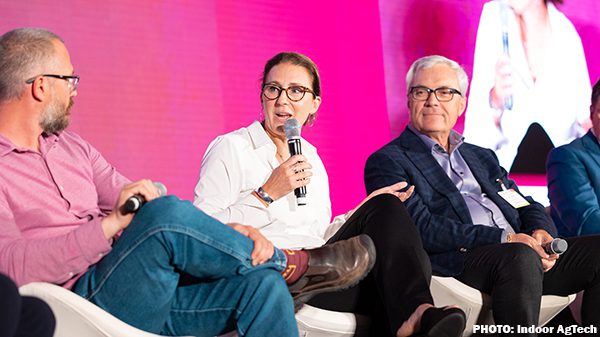BROOKLYN, NY—While billions of dollars have been invested in indoor farming, is there a financially-sustainable future? Investment dollars have paid for high-tech innovation, but it comes with higher upfront costs, higher unit costs, and a larger carbon footprint.
So where are we now? And where are we headed? These were the topics at Indoor AdTech in Brooklyn in June.
1. Maturation of the Business Model
At the beginning of vertical farming, early companies had to develop everything from lights to towers to growing recipes. They had to buy off-the-shelf genetics, figure out how to grow, brand their product, and distribute to, sell, and support retail. We are going to see a disaggregation in vertical farming. The pick and shovel company equivalents are developing superior technology around lights, digitization, AI, and automation — and also marketing, distribution, and branding.
Indoor farms no longer have to be vertically integrated and develop and manage all parts of the chain. We are also going to see more consolidation of growers and the blurring of lines between indoor and outdoor growers. Outdoor growers are seeing indoor farms as a way to spread their risk and make sure they have quality product in their offering year-round in times of high transportation costs and lessening availability to water. We are already seeing more turn-key operations where developers of farms will license/sell farms. We are also seeing hybrid models of hoop house and green house and vertical farms preforming different functions at the same location.
At Indoor AgTech there was talk of branching outside leafy greens to berries and other vegetables. And off stage, there was talk about the use of vertical farms to do outdoor crop breeding and to produce pharmaceuticals and botanicals for perfume.
2. Genetics
Indoor farms have been using genetics developed for outdoor use — crops that battle pests along with variability in moisture and weather.
In a world where every day is weather-perfect; what flavor, nutrition, improved architecture, and yield can genetics bring forward? Can we breed fruits and vegetables that require less prep time (and less labor) for chefs?
While acknowledging that it is not easy to just swap out better flavor for disease resistance, panelists were excited about what could be done for indoor. Unfold and Vindara are breeding selectively for indoor farms while the traditional seed breeding companies like Rijk Zwaan are starting to ask indoor growers what they want and breeding for them. This is going to allow for increased flavor profiles and interesting varieties for customized mixes. Because of regulation of gene editing as a GMO in Europe and uncertainty about consumer/retail acceptance in the US, produce developed using gene editing is not in the current pipeline.
But companies said it is a tool they are using to speed up breeding by understanding what to breed for while using more traditional techniques. In an industry based on technology, this is a waste of time and money but hopefully consumers and regulators will eventually accept new molecular breeding techniques to unlock even more genetic wins for indoor.
3. Energy: The Elephant in the Room
The industry is taking on the biggest complaint of vertical farming – carbon footprint and energy use – head on. A recent NYT opinion piece discussed various studies in the United States, Europe and Canada that estimated production of a pound of tomatoes in an American or Northern European greenhouse used about six times the carbon footprint of field tomatoes, even after considering emissions from refrigerated transport trucks traveling hundreds to thousands of miles to consumers.
Industry leaders insist the entire system must be taken into account, not just what is being used but what is being produced. Indoor produced crops allow for reduction of food waste, less transportation miles, fewer pesticides and water and less land use. The industry needs to continue to make the entire chain more energy efficient using innovation to bring down energy use and carbon footprint. Renewable energy and thoughtful placement of farms will help. Leadership in the industry is looking for ways to measure and communicate decreasing energy use.
4. Financing
Type and scale of financing is a big topic for the young industry. Over $3 billion in venture captial has been invested into vertical farms.
Many of the companies with $500 million to $1 billion in investment will likely go public for a positive exit.
There are still companies looking for venture funding, but much of the industry is moving beyond that stage. Venture capital has helped the industry move forward, now it must evolve to develop positive unit economics. The industry is seeking project financing and infrastructure financing to build and scale with a lower cost of capital. As companies apply for project financing there will be more transparency (and scrutiny) on unit economics and the drive to continually lower costs.
5. The Other Elephant: Who is the customer?
When indoor farming first started to scale, the conversation was all about the technology, but customers were often not part of the conversation.
As the industry matures, growers are realizing that growing the best product does not matter without a sustained buyer. Retailers talked about the leap of faith it has been to depend on SKUs coming from an indoor farm at first. They want strategic relationships with indoor farms, and they want farms to educate consumers, but there is only so much that can be communicated on a package label.
QR codes and websites can help, but online marketing for home delivery has been a benefit for more informational content and feedback from the consumer. Local has strong appeal, but freshness, taste, quality, and shelf life are the biggest selling points for indoor grown products. Another common theme was cost at retail must be reasonable and quality premiums only go so far.
6. Food Security
As a result of COVID and conflict-driven trade limitations, countries are increasingly worried about food security, particularly those that depend on imports. People are feeling the need and urgency for food supply resulting in a swing to domestic growing.
The last time we saw this significant a shift was during WW II when the Netherlands developed its domestic greenhouse industry to avoid famine. We likely will see more money invested in countries that cannot produce food outdoors domestically. Governments in the Middle East and Singapore are deploying Indoor farming as a strategy to overcome their land and water limitations.
 Indoor agriculture is no longer niche and continues to develop and scale to become an important part of the global produce industry. The future is bright for indoor farming as the industry continues to produce differentiated products that consumers understand and want.
Indoor agriculture is no longer niche and continues to develop and scale to become an important part of the global produce industry. The future is bright for indoor farming as the industry continues to produce differentiated products that consumers understand and want.



